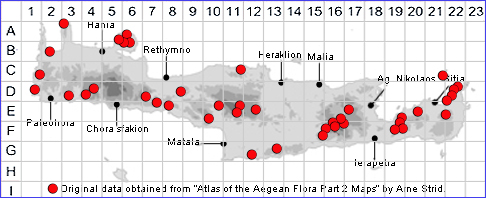TULIPA CRETICA
Family and Genus:- See- LILIACEAE/Sect. ERIOSTEMONES
Common Names:- Cretan tulip
Homotypic Synonyms:- None
Meaning:- Tulipa. Derived from the Persian word thoulyban, for a turban.
Cretica (L) From Crete, Cretan.
General description:- Low to short, hairless perennial.
Bulb:-
1) c. 2 x 1.5 cm, ovoid, usually not stoloniferous; tunics subcoriaceous, dark
brown to reddish-brown, prolonged into a short neck.
Stem:-
1) 4-12 cm, often purplish above.
Leaves:-
1) 2(-3), at ground level, patent-falcate or somewhat twisted, 0.5-2 cm wide, dull
green, often with purplish, glabrous or short-ciliate margins.
Flowers:-
1) 1(-3), 15-30 mm, opening widely.
2) Perianth segments, narrowly elliptic-oblong, acute, usually pale purplish-pink
on both sides or white above, with a yellow blotch at the inner base.
a) outer segments, 15-30 x 4-9·5 mm, elliptical, subacute,
b) inner, 16-32 x 6-11 mm, elliptic-oblong, subobtuse.
3) Stamens, hairy at the base of the filaments.
a) filaments, 5-8 mm.
b) anthers, 1·5-3 mm.
Fruit:-
1) Capsule, 9-15 x 10-15 mm, globose.
Key features:-
1) Perianth-segments, not more than 30 mm. white, pink, purple or orange-brown,
usually with a basal blotch or zone inside.
2) Anthers, not more than 3 mm.
Habitat:- Open habitats and dry open shrubby vegetation in rich terra rossa, rocky
and stony mountain slopes. 0-1600(-2100). on various substrates.
Distribution:- Cretan endemic. Fairly widespread but not too common.
Flowering time:- Mar to mid-May.
Photos by:- Steve Lenton
SPECIES DESCRIPTION

